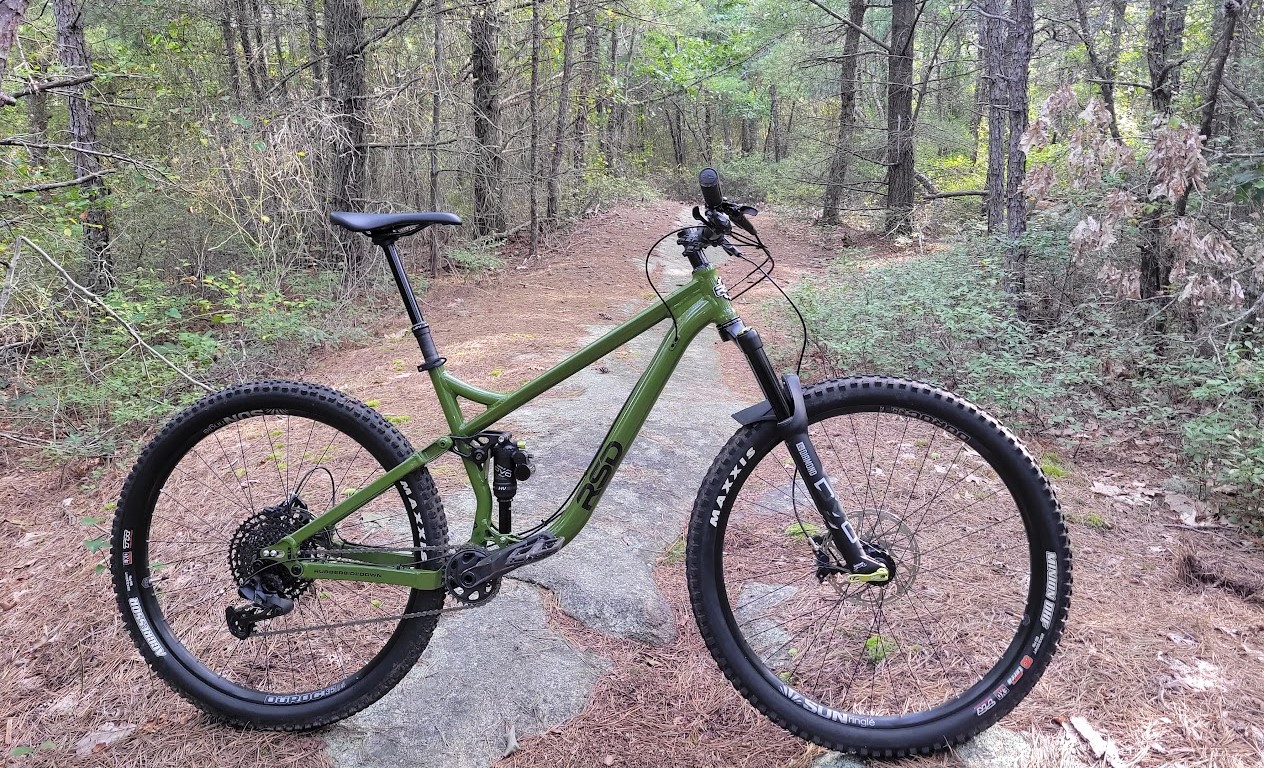RSD (Rubber Side Down) is a small Toronto brand known for its no-nonsense metal bikes. Since 2012, RSD has been selling hardtails and fat bikes made from aluminum, titanium, and steel. And more recently the full suspension Wildcat.
I’ve wanted to try a Wildcat since the first model was released in 2017. Its progressive geometry was ahead of the trend of slacker trail and downcountry bikes. The Wildcat 125 V3 is the current iteration, and like its V2 predecessor, it has an adjustable alloy frame for 27.5 or 29 wheels, or mixed-wheel mad science. The V3 improvements include 5mm more rear travel, room for longer dropper posts, and internal cable routing.
Riding DVO suspension was also on my to-do list, with its reputation for adjustability and low maintenance. After a summer on the Wildcat V3 I can report it met my expectations for value, quality, and fun wheel-size tinkering. With the 140mm fork, 65º headtube, and a long and low frame, it’s an outstanding descender despite only having 125mm or rear travel.
Value and Quality

Our Wildcat 125 V3 test bike was set up with SRAM GX and DVO 2 suspension, and is currently selling at $3,599 USD ($4,299 CAD). There is a higher priced DEORE spec at $3,749 USD ($4,499.00 CAD), and a frame only option is available for $1,599.00 USD ($1949.00 CAD).
RSD sells directly to riders, which helps the small company stay price competitive. The build was straightforward, but was more DIY than bikes from bigger direct to consumer brands. It took me a couple-few hours of cable routing trial and error, and dropper post cable fishing, but no special tools or skills were required. While setup instructions were vague, Alex was online and responded immediately (FYI the rotors are in the box, taped to the side of one the cardboard wheel sleeves).
The Wildcat is a good value, with a unique frame and excellent parts spec. The Horst-link frame is 7000 series aluminum alloy, designed by RSD in Ontario and manufactured in Taiwan. The nearly 8lb frame is beefy and industrial looking, with stainless hardware, stack-of-dimes welds, an ISCG05 BB shell, and other CNC pieces like the adjustable dropouts. The Wildcat is a different animal, an adjustable bike that’s also budget-friendly and can rail techy trails. I can see it appealing to both experty bike nerds and aggro trail rippers.
But per Keith Bontrager’s pick-two limit of strong, light, or cheap, something had to give, and it’s a heavy bike. The size Large test bike is 35.5lbs. This is noticeably heavier than the carbon downcountry rigs out there, but the alloy Wildcat costs a lot less.

29er RSD Wildcat V3 Build
- Sun Ringlé Düroc alloy wheelset with 35mm rims (with 15x110mm & 12x148mm hub spacing)
- Maxxis 2.5 tires (Minion DHF 3C Maxx Terra EXO front and Aggressor 3C Maxx Terra rear),
- SRAM GX Eagle 12 spd drivetrain (11-50t, 30t front ring)
- 175mm GX cranks
- SRAM G2 RSC brakes (180mm rotors)
- DVO Diamond D2 140mm Fork
- DVO Topaz T2 125mm shock
- KS LEV 175mm dropper
- Race Face 35mm Aeffect 780mm bars
- FSA Comet 35 50mm stem
- Cane Creek headset
- Cionlli saddle
Build Details
DVO provides the Diamond D2 140mm fork and Topaz T2 125mm shock, which I hadn’t ridden previously. I skimmed some online forums while searching for a setup guide, and saw comments about finicky settings. But I followed the guide for my weight and was riding happily right away and throughout the test. I would adjust pressure in the fork later, but generally kept the shock per the setup guide, which was relatively soft at 30% sag. With only 125mm to work with, I liked the supple setup.
Most of the time, I left the compression switch open, even though it bottomed-out a bit more often than I’d normally allow. I didn’t have a chance to try it out, but the Topaz can be tuned with volume spacers which would have made it more progressive to avoid bottoming out. The firm setting was seldom used, but I would flip the lever for a long fire road climb.
The KS LEV 175mm dropper, Cionlli saddle, Race Face 35mm Aeffect 780mm bars, Cane Creek headset, and FSA Comet 35 50mm stem round off the build. My only complaint is the awkward cable routing, especially around the bottom bracket, where tolerances between cables and moving cranks are very tight. I’m a worrier, so I zip tied them in a dozen spots, which looks a bit cheesy but nothing ever rubbed or caught.

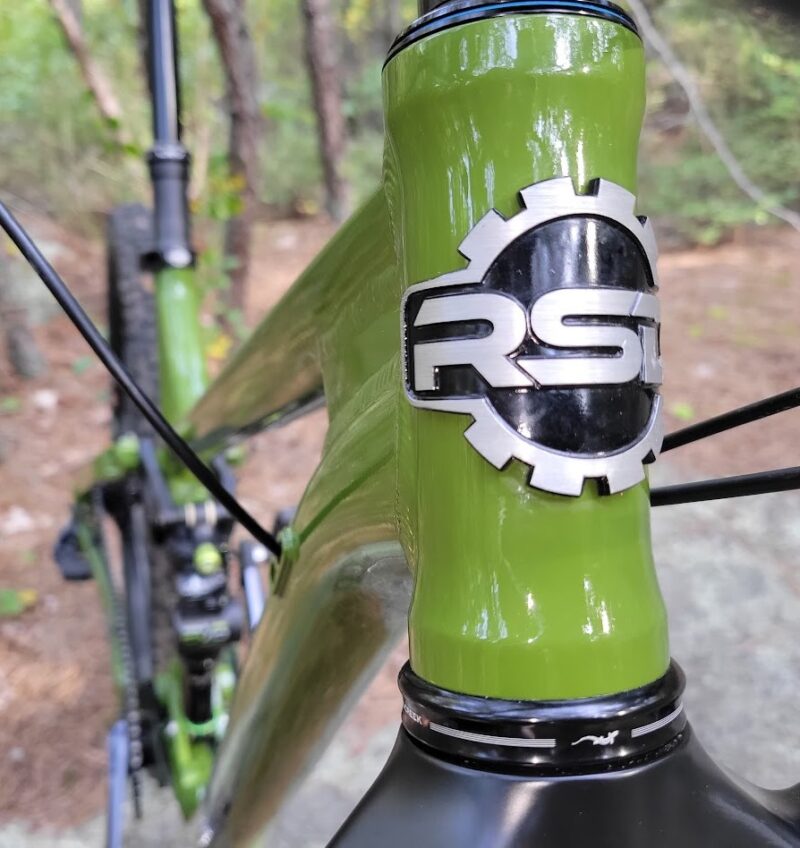
Geometry, Ride, and Wheel Size Tinkering
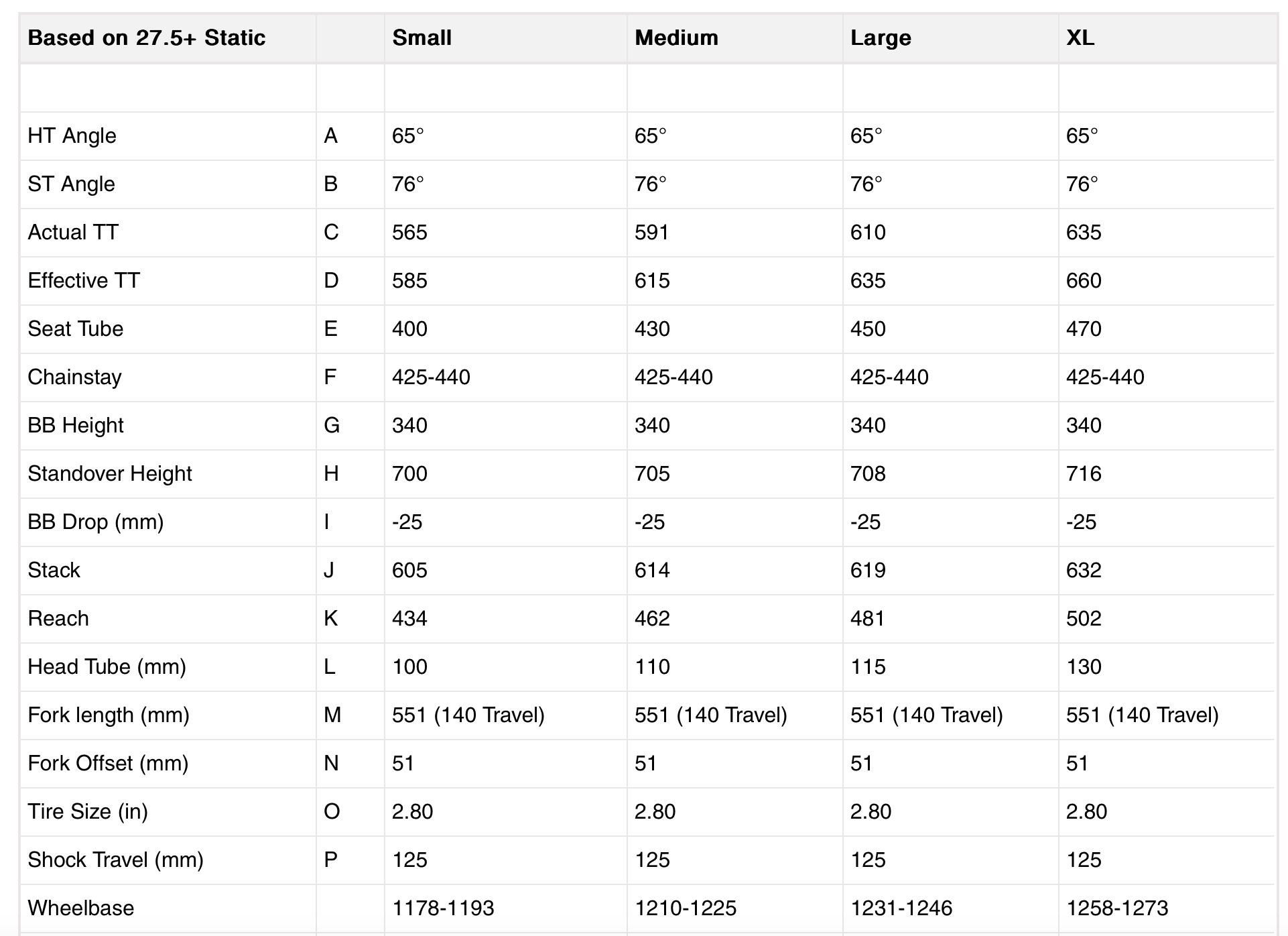
That 65º headtube is on the slack end for a trail bike, and as a large 29er the longish reach (481mm) and 440mm chainstays all add up to long 1246mm wheelbase. Body position is relatively upright and felt balanced between the wheels and even a bit rear wheel biased with the handlebar set almost as high as it could go.
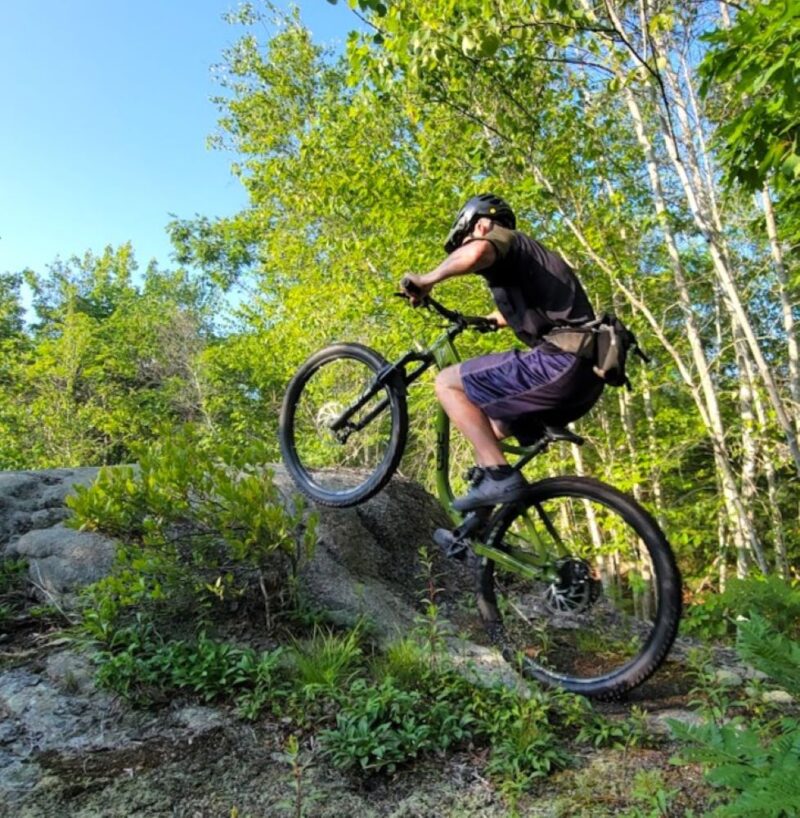

The Wildcat is a good climber, with a relatively steep 76º seat tube angle and good traction. The overall bike weight is noticeable though, especially on stop-and-go techy climbs. But once moving, the Wildcat feels efficient to pedal and is easy to maintain speed. I have long legs for my height, so despite the steep seat tube angle, I still had the saddle railed all the way forward. The supple but short rear travel helped on the technical climbs, but I found it to be a lot of bike to turn on slow-speed tight and twisting climbs. However, for the straight-line ups, I could slide way up to the intimate bit of the saddle and keep the front end down. I cleared my test loop super steep “1 in 10” climb on the first try.
MX Too?
As a fan of 27.5+, I was psyched to mix-wheel (MX) the Wildcat. My neighborhood trails are dominated by granite slabs and boulders. So while I love 27.5+ bikes for rear wheel grip, the wide front tire and low pressure often creates a counter-steering wrestling match. The front wheel on my plus bike likes to reach out and grab every passing boulder. MX seemed the perfect solution, so I slapped on a 3.0 clad 27.5+ rear wheel and slid the adjustable dropouts forward.
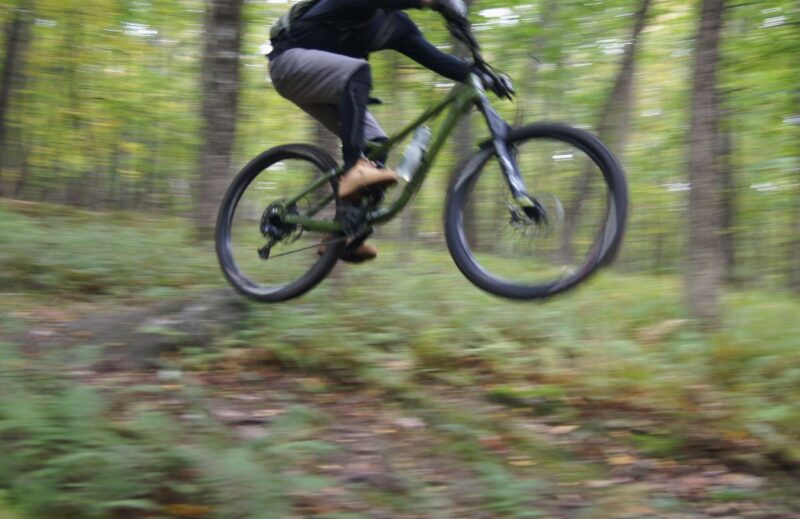
The trail bike MX was genius in theory, but my results have been, well, mixed. A 3.0 tire on a 27.5” rim is significantly shorter than the 2.5in 29er. A clue should have been the 15mm available inward slide of the dropout. The smaller diameter rear wheel drops the rear of the bike by 1/2″ or so, and seemed to lighten the front noticeably on climbs.
Loop outs and pedal strikes were easy to blame on the MX setup, deserved or not. And steep rock slab climbs had more front wheel flop. However, descents still felt great ala MX. I need to test more, including trying MX without the adjusting the chain stays in. Especially in wet or loose conditions, the improved rear tire traction might yet win me over. I also plan to bring the shorter wheel up to the bike park, where it can only help my “jumping”. Science is hard, but fun.
Ride Notes
- Rider: John Herron
- Rider Age: 51
- Rider Height: 5′ 11″
- Rider Weight: 170lb
- Size Tested: Large
- Location: Gloucester, MA
Pointed downward or on rolling flowy terrain was pure joy on the RSD. I ran the stem pretty high and let this big, small-travel bike loose. I never felt under-biked, even on fast and chunky descents. On trail bike trails, everything was in play, including scrappy bike park blue trails with waist high drops and sketchy rock gardens. My coastal trial course neighborhood trails were fine, but the hillier trails and actual mountains are where the Wildcat shined. It held speed down rocky and rooty trails, but still felt connected with the terrain so that even really small features could be popped. But it’s stable and squishy enough so I could lift the bike confidently over messy sections, even if the landing strip looked questionable.
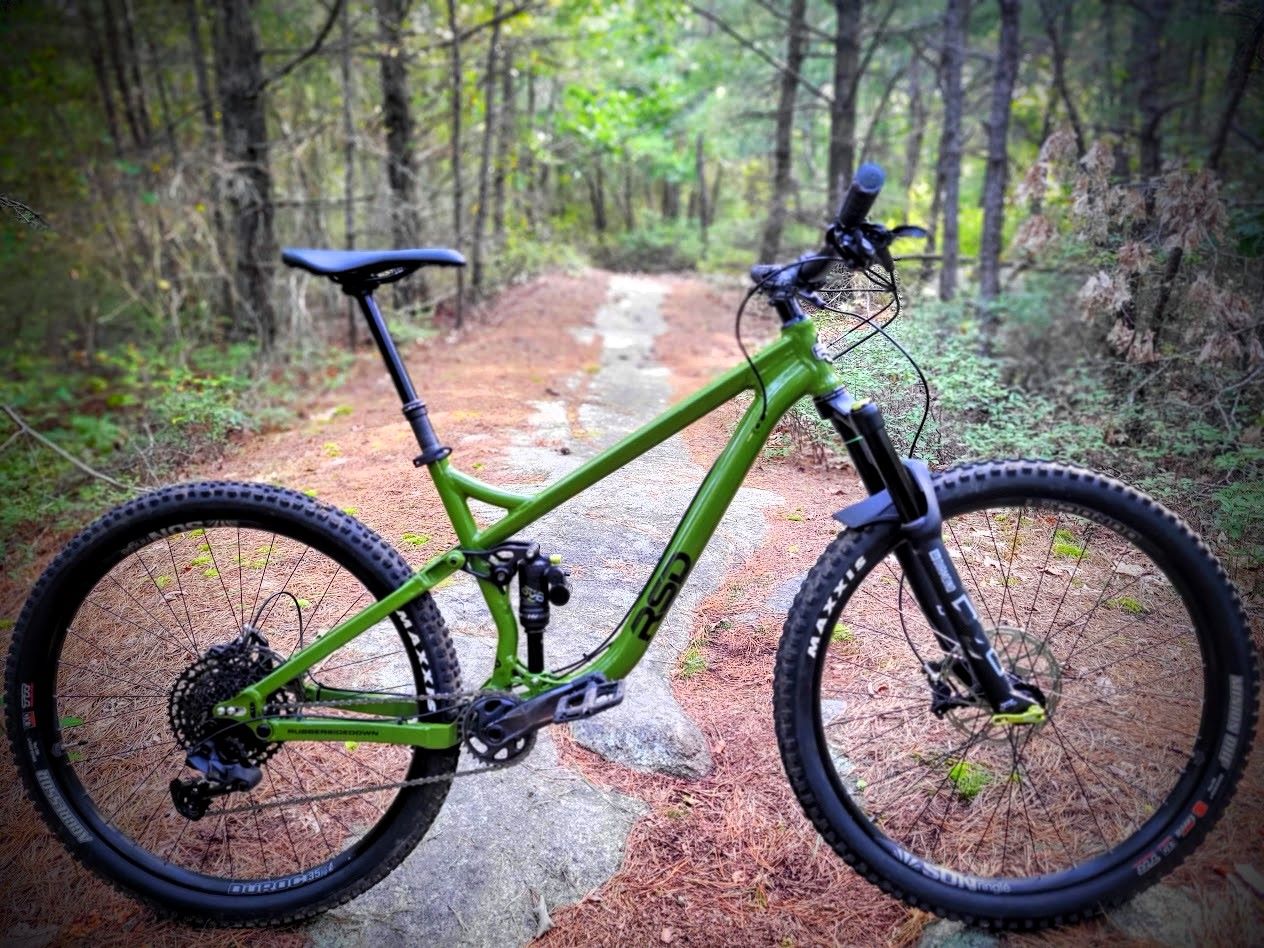
Summary
The RSD Wildcat 125 V3 is a short travel trail bike with the progressive geometry once reserved for enduro bikes. The burly alloy frame has adjustable dropouts, leaving options open for 29 or 27.5+ wheels. With DVO’s D2 140mm fork and smooth T2 shock offering 125mm of rear travel, it excels in rough terrain like it had more travel. At under $4,000 USD it’s a good value, but don’t confuse it for a lightweight downcountry or XC racer. The Wildcat is focused on fast and stable descending, while keeping the rubber side down on the roughest of trails.
Pros:
- Good value
- Progressive geometry
- Rowdy trail bike fun
- Adjustable dropouts
Cons:
- Heavy
- Awkward cable routing
Price: $3,599 USD ($3,949 as tested with dropper)
Check out a Wildcat if you’re a bike nerd or trail ripper, or one of the lucky ones like Alex (and Keith) who are both. It’s a confidence inspiring trail machine with a unique design, burly hand-made looks, and a luscious paint job. And a great parts spec for the price. I thoroughly enjoyed the Wildcat 125 this summer, and have more experiments planned. There is also a 150mm version available for pre-sale on the RSD website. I want to do the research, but it’s a safe hypothesis that the 150 version will be a fast all-mountain descender.
